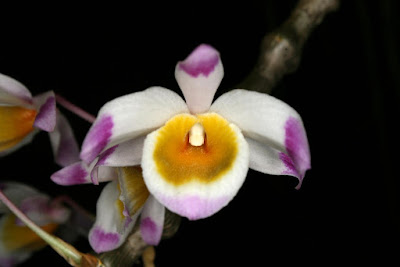Dendrobium pendulum is found in Hainan and Tibet China, Assam, Bangladesh, Myanmar, Thailand, Laos and Vietnam. It grows in open forests on tree trunk at elevations of 760 to 1600 meters above sea level.
Dendrobium pendulum also called as The Pendant Growing Dendrobium, Callista crassinodis, Callista pendula, Dendrobium crassinode, Dendrobium crassinode f. albiflorum, Dendrobium crassinode var. barberianum, Dendrobium melanophthalmum, is a species of the genus Dendrobium. This species was described by William Roxburgh in 1832.
IDENTIFY DENDROBIUM PENDULUM ORCHID PLANT
Dendrobium pendulum is found in Hainan and Tibet China, Assam, Bangladesh, Myanmar, Thailand, Laos and Vietnam. It grows in open forests on tree trunk at elevations of 760 to 1600 meters above sea level.
It is a small to large sized, warm to cool growing epiphyte or lithophyte with tufted masses, decurved or pendulous, 7 to 16 noded, swollen at each node, sulcate, dull olive-green stems carrying deciduous, lanceolate, semi-amplexicaul, acute leaves.
The Pendant Growing Dendrobium blooms in the fall through spring but mostly in the late winter and early spring on an axillary, short, few flowered inflorescence with boat-shaped, papery floral bracts that arise from the upper nodes on leafy and old leafless canes carrying fragrant, long-lasting flowers. The flowers are from 2 1/2 to 3 inches across and have equal sized, oblong, pointed sepals and petals, white, with amethyst to purple tips and a kidney-shaped, spreading, velvety lip, white, marked with yellow and amethyst at the tip. Like a number of the other Dendrobiums this species does not seem to flourish for more than about three years under cultivation. It has a tendency to mould and damping off.
The var. albiflorum (Sepals, petals and labellum are pure white. Yellow blotch at throat); Var. Barberianum (Plant more vigorous in habit and bloom-flowers last longer and are more richly coloured-throat and middle of labellum blotched with deep orange).
DENDROBIUM PENDULUM ORCHID PLANT CARE AND CULTURE
Cultural information should only be used as a guide, and should be to be adapted to suit you. Your physical location; where you grow your plants, how much time you have to devote to their care, and many other factors, will need to be taken into account. Only then can you decide on the cultural methods that best suit you and your plants.
Light:
Dendrobium pendulum do best in full sunshine (25000-50000 lux), close to the glass where glasshouse treatment is required. In addition to the natural light, you will have to use artificial light lamps.
Temperature:
The average temperature of the summer day is 25-26 ° C, night 21 ° C, giving a daily difference of 4-6 ° C. In winter, the average day temperature is 27-30 ° C, night 16-17 ° C, giving a daily difference of 13 ° C.
Humidity:
From the end of spring to autumn, The Pendant Growing Dendrobium need the humidity of almost 80%, in winter and at the beginning of spring it drops to almost 60%.
Too dry air has a negative effect on the development of the plant: its growth is inhibited, and the leaves begin to turn yellow and dry out. The higher temperature, the higher the humidity should be, and the higher the humidity, the more often and longer it is necessary to ventilate the room where the plants are contained, otherwise the probability of rotting and various kinds of fungal diseases.
Substrate, growing media and repotting:
Dendrobium pendulum grows best in wooden baskets with staghorn peat as substrate (line the bottom with a few large pieces of wood-charcoal, which helps to provide aeration, and counteracts any tendency of the compost to ferment). The pseudobulbs can be tied, where necessary, to the hanging wires, thus ensuring stability.
It does not need frequent repot, therefore, it is desirable to transplant only when it is really necessary, for example, in cases of strong salinization or compaction of the substrate, at its critically high or low pH (the norm is from 5.5 to 6.5) or when the plant grows very strongly and the pot becomes cramped to it (pseudobulbs begin to hang from the edges of the pot). Repotting is best done immediately after flowering when new roots and new growth begin to grow.
Watering:
Although this plant like plenty of applied water in the Summer, they do best in a dry atmosphere. Watering is directly dependent on the temperature of the content, the higher it is, the more often it needs to be watered. When watering, excess water should flow freely from the pot, since stagnation of water both inside the pot and in its pan can very quickly lead to rotting of the roots and the lower part of the plant.
Fertilizer:
It is recommended to use a 1/4-1/2 dose of orchid fertilizer weekly. You can use the balanced fertilizer throughout the year or from spring to mid-summer use high-nitrogen fertilizer, and then until the end of autumn high-phosphoric fertilizer to stimulate flowering.
Rest period:
Dendrobium pendulum need less water in the winter, especially if they grow under the conditions of a dark, short day that occurs at moderate latitudes. They should dry somewhat between waterings, but they should not be dry for a longer period. Frequent morning fogging and rare, economical watering should allow the plant to go through a dry period of rest, while providing it with sufficient humidity. Fertilization should be reduced or eliminated until new growths appear and a more abundant spring watering begins.















COMMENTS